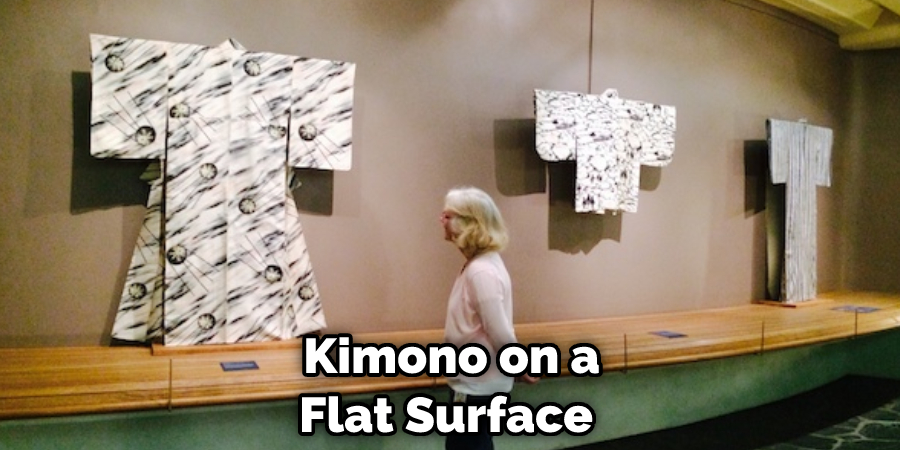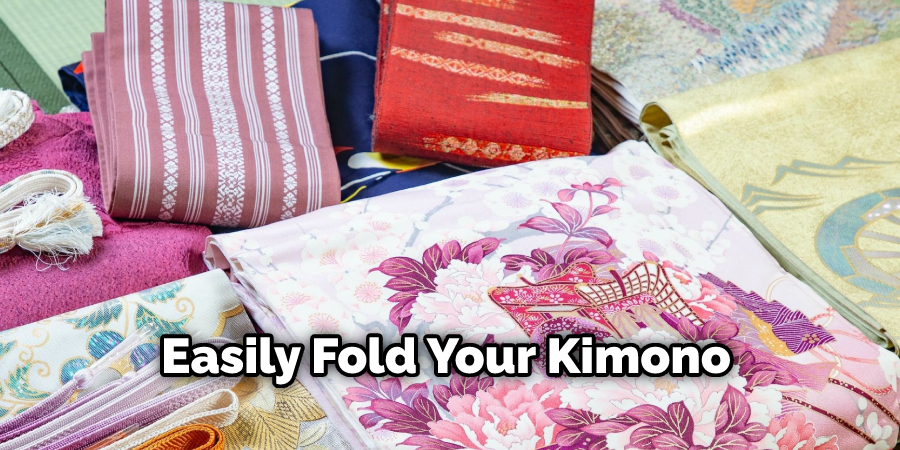Are you fascinated by traditional Japanese kimonos but don’t know how to fold them properly? Kimonos have been a symbol of beauty, honor, and respect in Japan for centuries. While the intricate designs, prints, and fabrics make them quite lovely to behold, their shape requires a special folding technique that requires patience and attention to detail.

Fortunately, this post has all the information you need to learn how to fold a kimono! We’ll walk step-by-step through the various folds required so you can proudly display your own kimono with confidence.
What Holds a Kimono Closed?
A kimono is typically fastened using an obi sash or belt. The obi is usually made of stiff fabric and can be tied in the front, back, or sides depending on the style. It is also held together with two han-dons (or “half knots”) – one on each side to keep it secure.
Other traditional accessories such as a DateTime (a decorative waist piece) and himo (cords) are sometimes used to hold the kimono properly closed. In modern times, some people prefer to use a safety pin for added security if needed.
When wearing a kimono for formal occasions, however, most people still choose to use an obi sash and han-dons. With the correct tying technique, these traditional methods can be quite secure and stylish!

No matter how you choose to fasten your kimono, it is essential that you make sure it stays securely closed. A well-tied obi will keep the sides together and allow for free movement without having to constantly readjust or worry about your kimono coming undone.
Taking the time to learn how to properly tie an obi sash is an important part of wearing a kimono – not only for keeping everything in place but also to complete the look with traditional Japanese style!
9 Methods How to Fold a Kimono
1. Lay the Kimono Out Flat on a Surface:
Begin by laying the kimono flat on a surface such as a bed, floor, or table. Make sure the fabric is lying flat with no wrinkles or creases before starting. To make it easier, you can use pins to hold the kimono in place.
While doing this, be very careful to avoid damaging the fabric. Although kimono fabric is usually quite sturdy, it can still be easily torn or snagged. However, if you take your time and handle it with care, you should have no problem.
2. Right Side of Kimono Facing Up:
Make sure that the right side of the kimono is facing up so you can see any embroidery and/or other decorations that might be on it. Place the kimono on a flat surface with the bottom of it closest to you.

With the left sleeve in your left hand and the right sleeve in your right hand, find the middle of the sleeves and bring them together so that they overlap one another. Gently pull up the top of the kimono and wrap it around itself, folding it in half lengthwise. Make sure that the embroidery and/or decorations remain on the outside of the fold.
Continue folding the kimono in half until it is just slightly larger than the size of your hands. Take both of the sleeves and cross them in front on top of each other so that they form an X-shape. Then, fold the bottom of the kimono up and over the X-shape.
3. Fold in Half Vertically:
Take both sides of the kimono and fold them towards each other vertically so that the edges line up. It should now be folded into quarters after this step has been completed. Then, tuck the sleeves of the kimono into the folded material.
This will help to keep it in place and make for easy storage. On the outside of the folded kimono, you should now be able to see a few creases that help make it look neat and tidy. If there are any wrinkles, try to smooth them out gently. However, be careful not to tug too hard on the fabric.
4. Fold in Half Horizontally:
Take the two sides of the kimono and fold them towards each other horizontally. This should create a long, thin shape. Make sure that the edges of the kimono match up and that there are no gaps or wrinkles in the fabric. Secure the fold with a few pieces of tape if necessary.

Holding your kimono in this way makes it easier to store and transport. Though the kimono is usually folded vertically, folding it horizontally will help it to fit more easily in a bag or suitcase. Additionally, this method of folding is much quicker than the traditional technique.
5. Fold in Half Once More:
Take the two sides of the kimono and fold them towards each other once more so that it is now folded into an even smaller rectangle. Make sure that the edges are lined up and that it is nice and neat. If necessary, use your hands to smooth out any wrinkles. Try to keep the folds crisp and clean.
Although folding the kimono is an art form, having your kimono perfectly folded will help it look its best. Try to keep it as symmetrical as possible. While folding, it is important to remember that the kimono should still fit in the bag you will use for storage. Once you have finished folding, your kimono is ready to be stored. You can now enjoy the beauty of wearing a kimono!
6. Roll from Top to Bottom:
Starting at one end of the kimono, roll it from top to bottom until you have rolled up all of the fabric. Make sure that you are rolling tightly so that there will be no wrinkles or creases in your final product. Use your hands to carefully hold the roll together as you go.
Once you have completely rolled up the kimono, the end result should be a neat and tidy package with no wrinkles or creases. While folding a kimono is quite simple, it can take some time to get used to the technique.
With practice, you should be able to fold a kimono quickly and efficiently. Be sure to follow the steps carefully for the best results. Folding your kimono properly is essential in keeping it looking good for years to come!
7. Tie with a Ribbon:
Wrap a ribbon around the length of the rolled-up kimono and tie it into a bow for easy storage and transport. If the kimono has an obi, use this instead; a traditional box fold will ensure it is kept secure. Make sure to store the kimono in a dry, cool place and out of direct sunlight to ensure its longevity.
With these steps, you can easily fold your kimono like a traditional Japanese garment! Additionally, you can also fold the kimono into a triangle to make it easier for transport and storage. Start by folding the kimono in half lengthwise.
Take one of the corners and fold it over so that its edge meets the center crease. Then take the opposite corner and fold it on top of that. The extra fabric will form a triangle. Wrap the sash around the kimono and tie it securely for storage or transport.

8. Fold in Half Again:
If you are going to be storing the kimono for a long period of time, fold it in half one more time so that it will take up less space and will not get wrinkled or creased. Make sure to smooth out any existing wrinkles or creases before doing this. You can also use this technique if you are traveling and need to conserve space in your suitcase.
Be careful not to put too much pressure on the fabric while folding, as it may tear or stretch. Once finished, secure the kimono with a belt or a sash to keep it in place. You can also use a large safety pin or an elastic band for this purpose.
9. Place Inside a Kimono Bag:
Put your folded kimono into a special kimono bag for extra protection against dust and moisture. These bags are usually made of muslin or cotton and come in a variety of sizes. Choose a bag large enough to fit your folded kimono comfortably, and close the bag securely with a drawstring or zipper.
If you plan to store your kimono for long periods of time, consider finding a bag that’s made of breathable fabric or with mesh panels to let air circulate inside. Finally, put the kimono bag in a drawer or closet that’s not exposed to sunlight, moisture, and other factors which might damage the fabric.
Conclusion
Now that you have learned the basics of how to fold a kimono, you can confidently display them in your home or closet or present them as a gift to somebody close to you. This ancient Japanese tradition is part of their culture and identity and one which you can now be part of. With this newfound knowledge and skill, folding a kimono will never seem daunting again.
You Can Check It Out To-Crochet a Llama


